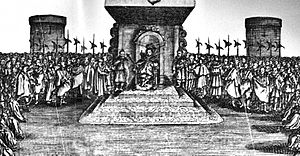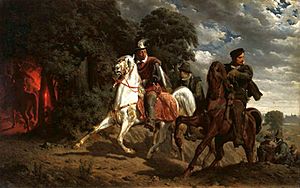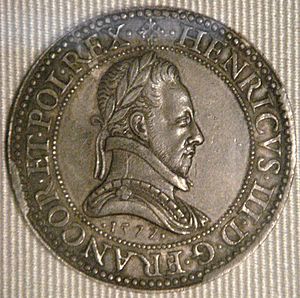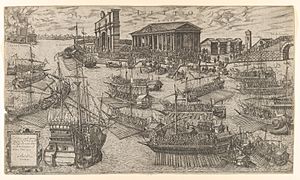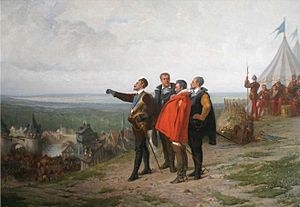Henry III of France facts for kids
Quick facts for kids Henry III |
|
|---|---|
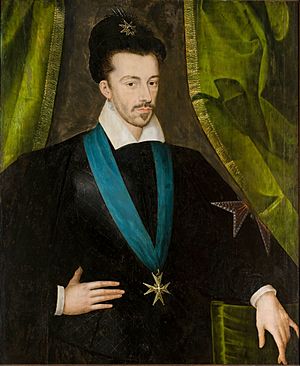
Portrait by Étienne Dumonstier, 1578
|
|
| King of France (more...) | |
| Reign | 30 May 1574 – 2 August 1589 |
| Coronation | 13 February 1575, Reims |
| Predecessor | Charles IX |
| Successor | Henry IV |
| King of Poland Grand Duke of Lithuania |
|
| Reign | 16 May 1573 – 12 May 1575 |
| Coronation | 22 February 1574, Wawel |
| Predecessor | Sigismund II Augustus |
| Successor | Anna and Stephen |
| Interrex | Jakub Uchański |
| Born | 19 September 1551 Château de Fontainebleau, France |
| Died | 2 August 1589 (aged 37) Château de Saint-Cloud, France |
| Burial | Basilica of St Denis, France |
| Spouse | Louise of Lorraine |
| House | Valois-Angoulême |
| Father | Henry II of France |
| Mother | Catherine de' Medici |
| Religion | Catholicism |
| Signature |  |
Henry III (born Alexandre Édouard on 19 September 1551) was the King of France from 1574 until 1589. Before that, he was also the King of Poland and Grand Duke of Lithuania from 1573 to 1575.
Henry was the fourth son of King Henry II of France. Because he was not expected to become King of France, he was a good choice for the empty throne of the Polish–Lithuanian Commonwealth. He was chosen as their ruler in 1573. During his short time as king there, he signed laws that gave nobles the right to choose their own king.
When his brother, Charles IX, died without children, Henry became King of France. He left Poland–Lithuania when he was 22 years old to take the French throne. At this time, France was facing many problems because of the Wars of Religion. Henry's power was weakened by different groups who were supported by other countries. These groups included the Catholic League (backed by Spain and the Pope), the Protestant Huguenots (supported by England and the Dutch), and another group called the Malcontents. Henry III believed that a strong king who allowed different religions would save France from falling apart.
Later, when Henry's younger brother died and it became clear that Henry would not have an heir, the Wars of Religion turned into a fight over who would be the next king. This was called the War of the Three Henrys. Henry III's closest relative who could become king was his cousin, Henry III of Navarre, who was a Protestant. The Catholic League wanted to stop Protestants from becoming king. They supported a Catholic leader, Charles, Cardinal of Bourbon, as the next heir.
In 1589, a Catholic friar named Jacques Clément killed Henry III. After Henry III's death, the King of Navarre became Henry IV. He became Catholic and was the first French king from the House of Bourbon.
Contents
Early Life
Childhood
Henry was born at the royal Château de Fontainebleau. He was the fourth son of King Henry II and Catherine de' Medici. His older brothers were Francis II of France, Charles IX of France, and Louis of Valois. In 1560, he became the Duke of Angoulême and Duke of Orléans. In 1566, he became the Duke of Anjou.
Henry was his mother's favorite child. She called him chers yeux ("precious eyes") and showed him much love. His older brother, Charles, did not like Henry, partly because Henry was healthier.
Youth

Henry was good at fencing, but he liked art and reading more. People thought these interests came from his Italian mother. Henry also enjoyed hunting and riding horses.
When he was young, Henry showed some interest in Protestantism as a way to rebel. At nine years old, he called himself "a little Huguenot." He only went to Catholic Mass to please his mother. He sang Protestant songs to his sister Margaret and told her to change her religion. His mother warned him about this behavior, and he never showed Protestant leanings again. Instead, he became a strong Catholic.
Henry was known for enjoying walks through Paris and spending time in busy neighborhoods. He liked fairs, music, and court shows. He was also a very religious Catholic. He brought religious changes to the city and encouraged the French church to follow the rules of the Council of Trent.
Elizabeth
In 1570, there were talks about Henry marrying Queen Elizabeth I of England. Elizabeth was almost 37, and many people in her country expected her to marry and have a child. However, nothing came of these talks. Historians believe Elizabeth only wanted to make Spain worried, not truly marry Henry. Henry's mother thought the marriage could happen despite their different religions (Henry was Catholic, Elizabeth was Protestant).
Wars of Religion
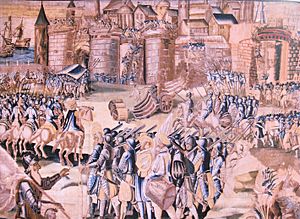
In 1567, Henry became the leader of France's military. He led the royal army and won battles against the Huguenots at Battle of Jarnac (March 1569) and Battle of Moncontour (October 1569). During this time, he was a key figure for strict Catholics at court.
Henry was involved in the St. Bartholomew's Day Massacre of 1572, a terrible event where many Huguenot leaders were killed. Henry III's time as King of France, like his older brothers', was always troubled by religious conflicts.
Henry continued to play an active role in the Wars of Religion. In 1572 and 1573, he led the siege of La Rochelle. This was a large military attack on the city held by Huguenots. In May 1573, Henry learned that Polish nobles had chosen him as their king. Because of this, he had to stop the siege. An agreement was reached in June 1573, and Catholic troops ended the siege in July 1573.
King of Poland and Grand Duke of Lithuania (1573–1575)
After the Polish ruler Sigismund II Augustus died in 1572, France sent a representative to Poland. They wanted Henry to be elected to the Polish throne. In return, France offered military help against Russia and financial support.
On 16 May 1573, Polish nobles chose Henry to be the first elected king of the Polish–Lithuanian Commonwealth. The Lithuanian nobles did not take part in this election, but their council later confirmed his election. The Commonwealth chose Henry over other candidates partly to have a better relationship with the Ottoman Empire, which was a traditional ally of France.
A group of Polish representatives went to La Rochelle to meet Henry. Henry left the siege after their visit. In Paris, on 10 September, the Polish group asked Henry to promise to "respect traditional Polish freedoms and the law on religious freedom." As a condition of becoming king, he had to sign agreements called the pacta conventa and the Henrician Articles. These promised religious tolerance in the Polish–Lithuanian Commonwealth. Henry did not like the limits on his power under the Polish-Lithuanian system of "Golden Liberty."
At a ceremony in Paris on 13 September, the Polish group gave Henry the "certificate of election to the throne of Poland-Lithuania." Henry also gave up any claims to the French throne at that time. He agreed to the idea of a free election under the Henrician Articles and the pacta conventa.
Henry did not reach Poland until January 1574. His coronation was held in Kraków on 21 February. In mid-June 1574, Henry learned that his brother Charles IX had died. Henry then left Poland and went back to France. Henry's absence caused a problem in Poland. The Polish Parliament told Henry that he would lose his throne if he did not return from France by 12 May 1575. Since he did not return, Parliament declared his throne empty.
Henry's short time at Wawel Castle in Poland showed the differences between Polish and French cultures. The young king and his followers were surprised by some Polish customs and by the country's rural poverty and harsh weather. The Poles, on the other hand, wondered if all Frenchmen cared as much about their appearance as their new king did.
In some ways, Polish culture had a good influence on France. At Wawel, the French learned about new ways to deal with waste, where it was taken outside the castle walls. When Henry returned to France, he wanted to build similar systems at the Louvre and other palaces. Other inventions from Poland that came to France included baths with hot and cold water, and dining forks.
In 1578, Henry created the Order of the Holy Spirit. He did this to remember becoming King of Poland and then King of France on the Feast of Pentecost. This Order became the most important knightly order in France until the end of the French monarchy.
French Reign (1574–1589)
Henry was crowned King of France on 13 February 1575 at Reims Cathedral. He married 21-year-old Louise of Lorraine on 14 February 1575. People expected them to have children, but they did not have any.
In 1576, Henry signed the Edict of Beaulieu, which gave many rights to the Huguenots. Because of this, Henry I, Duke of Guise, formed the Catholic League. After many talks, Henry was forced to take back most of the rights he had given to the Protestants.
In 1584, the king's youngest brother and the next in line for the throne, Francis, Duke of Anjou, died. According to French law, the next heir was the Protestant Henry of Navarre. He was a relative of Louis IX. The idea of a Protestant king led to the War of the Three Henrys. Under pressure from the Duke of Guise, Henry III issued a law that stopped Protestantism and removed Henry of Navarre's right to the throne.
Henry III was upset by the Duke of Guise's open disobedience. In May 1588, he tried to take control by sending royal troops into Paris. This made the people turn against him and support the more popular Guise during the Day of the Barricades. Henry III had to leave the city. He later sought support from the Paris Parliament and tried to set up an anti-League government across France.
After Spain's navy was defeated that summer, the king's fear of Spanish support for the Catholic League seemed to lessen. So, on 23 December 1588, at the Château of Blois, he invited Guise to a meeting. There, royal guards killed the duke and his brother. To make sure no one could act against him, the king had the duke's son put in prison. The Duke of Guise had been very popular in France, and the people turned against Henry for these killings.
By 1589, Henry's popularity was very low. Preachers were calling for him to be killed and saying he was a bad ruler. The people of Paris disliked him for his expensive court, allowing corruption, high taxes, and relying on Italian bankers.
Overseas Relations
Under Henry, France named its first Consul in Morocco. This was Guillaume Bérard. The Moroccan prince Abd al-Malik asked for Bérard, who was a doctor, because Bérard had saved him during a sickness in Constantinople.
Henry III also encouraged exploring and developing new lands. In 1588, he gave Jacques Noël, the nephew of Jacques Cartier, special rights for fishing, fur trading, and mining in New France.
Assassination and Burial
On 1 August 1589, Henry III was with his army at Saint-Cloud, getting ready to attack Paris. A young friar named Jacques Clément, who had fake papers, was allowed to see the king. The friar gave the king some papers and said he had a secret message. The king told his helpers to step back for privacy. Clément then whispered in his ear and wounded him. Clément was immediately killed by the guards.
At first, the king's wound did not seem deadly. But he told all the officers around him that if he did not survive, they should be loyal to Henry of Navarre as their new king. The next morning, on the day he was supposed to attack Paris, Henry III died.
His army fell into chaos, and most soldiers quickly left. The planned attack on Paris was put off. Inside Paris, people were very happy about Henry III's death.
Henry III was buried at the Saint Denis Basilica. He had no children. He was the longest-living son of Henry II to become king and the last of the Valois kings. Henry III of Navarre became his successor as Henry IV, the first king from the House of Bourbon.
Arms
-
Henry's coat of arms, showing his dual status as King of France and lifelong King of Poland.
See also
 In Spanish: Enrique III de Francia para niños
In Spanish: Enrique III de Francia para niños
- Chicot
- History of Poland (1569–1795)
- Les Mignons
- Louis Duret


